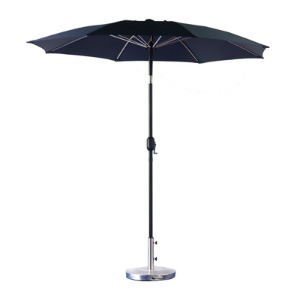A sun umbrella stand is an essential accessory for keeping a sun umbrella shade stable and secure. Whether you're setting up an umbrella in your backyard, patio, or at the beach, ensuring that the sun umbrella stand is properly installed is crucial for safety and durability. An improperly placed sun umbrella stand can cause to tipping over, posing risks of damage or injury. This guide will walk you through the correct installation process, highlight the techniques to prevent tipping, and ensure that your sun umbrella shade stays firmly in place.

270-8 Aluminum Alloy Upright 38 Engineering Rainproof Outdoor Umbrella
To start, selecting the right sun umbrella stand is key. Different stands are designed for various settings, such as weighted bases for patios, in-ground anchors for gardens, and sand-filled bases for beach umbrellas. The weight and material of the sun umbrella stand should correspond to the size and height of the sun umbrella shade. A heavy-duty sun umbrella stand is essential for larger umbrellas, while a lightweight stand may suffice for smaller, portable umbrellas.
When installing a sun umbrella stand, begin by choosing a flat and stable surface. Uneven ground can make the sun umbrella stand unstable, increasing the likelihood of tipping. For patio and garden setups, placing the stand on concrete or solid decking provides stability. If installing the sun umbrella stand on soft ground, such as grass or sand, ensure that the base is deep enough to provide support. Some sun umbrella stands come with spikes or anchors that help secure them into the ground more effectively.
Once the sun umbrella stand is in position, inserting the sun umbrella shade correctly is the next crucial step. Make sure the umbrella pole fits securely into the sun umbrella stand, and tighten any securing knobs or screws to hold it firmly in place. If the pole is loose, even a slight breeze can cause instability, causing to tipping. Some sun umbrella stands feature adjustable locking mechanisms that provide additional grip and support.
To further prevent tipping, adding weight to the sun umbrella stand is highly recommended. Many patio-style sun umbrella stands allow for extra weight plates, which can be placed on top of the base for added stability. Alternatively, sandbags or heavy stones can be used to reinforce the sun umbrella stand, especially in windy conditions. For beach umbrellas, filling the base with wet sand provides a stronger hold than dry sand, significantly reducing the chances of tipping over.
Another effective method to secure a sun umbrella stand is by using wind vents on the sun umbrella shade. Many modern sun umbrella shades include vented tops, which allow wind to pass through rather than pushing against the fabric, reducing the overall force applied to the sun umbrella stand. If your umbrella does not have a wind vent, positioning it at an angle rather than upright can help minimize wind resistance.
Regular maintenance of the sun umbrella stand is also important for long-term stability. Checking for rust, cracks, or loose fittings can prevent unexpected failures. If the sun umbrella stand is metal, applying an anti-rust coating can extend its lifespan. For plastic or resin sun umbrella stands, avoid prolonged exposure to direct sunlight when not in use, as UV rays can weaken the material over time.
Finally, when strong winds or storms are expected, it is advisable to close the sun umbrella shade and store it in a safe place. Even a well-secured sun umbrella stand may not withstand weather conditions, and removing the umbrella altogether is the way to prevent damage.
By following these installation and stabilization techniques, you can ensure that your sun umbrella stand and sun umbrella shade remain secure and functional. Proper placement, added weight, wind-resistant design, and routine maintenance all contribute to keeping your outdoor space safe and enjoyable.
